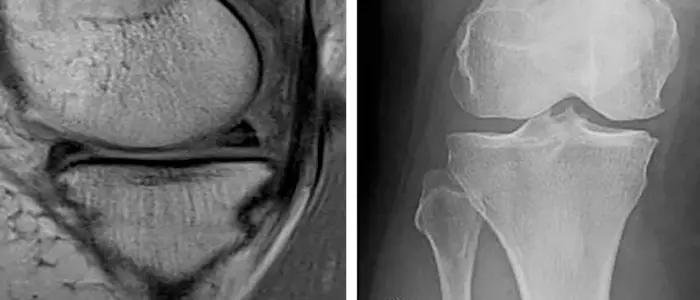- Home
- Research
- Achieving Excellence - Research at Washington University Orthopedics
- Standing X-Ray Versus MRI
Standing X-ray Versus MRI

Knee MRI (left) and knee x-ray (right).
Muyibat Adelani, MD, noticed an interesting trend while completing her residency in orthopedics at Washington University School of Medicine.
“I saw that many patients over the age of 40 that were coming in to be evaluated for knee pain had a MRI ordered by other physicians before coming to see an orthopedist,” she says. “Less than half of those MRIs provided us with information that guided treatment recommendations and, if they had significant arthritis, it was not helpful at all.”
MRI, or magnetic resonance imaging, scans can cost more than 12 times the cost of a simple X-ray, thereby dramatically increasing overall healthcare costs. Adelani says, though, that X-rays can be used to evaluate not only fractures, but also bone degeneration, such as what occurs in osteoarthritis.
In reviewing the cases of almost 600 patients aged 40 years or older who were referred to a sports medicine practice at Washington University School of Medicine, nearly one in four patients had a pre-referral MRI.
“Overall, we found that 40-percent of these patients were subsequently diagnosed with osteoarthritis,” says Adelani. “That’s significant because only 58 percent had had a standard X-ray and only 13 percent had a weight-bearing X-ray.”
The bottom line — over the course of the entire study, Adelani found that MRIs were not necessary in half of the patients. “A less costly X-ray would have provided enough clinical information.”
Her research, published in the September 2016 issue of the Journal of the American Academy of Orthopaedic Surgeons, is aimed at changing public and professional perceptions about the value and cost-effectiveness of X-rays and, in particular, weight-bearing X-rays, which can delineate loss of joint space.
“By using standing, or weight-bearing X-rays first, we can identify which patients have significant osteoarthritis and, thus, wouldn’t really benefit from getting an MRI,” she says.
Adelani, who now specializes in joint replacement and osteoarthritis adds, “Our research points to the need to change clinical practices.”
Next article: Orthopedic Research Clinical Core